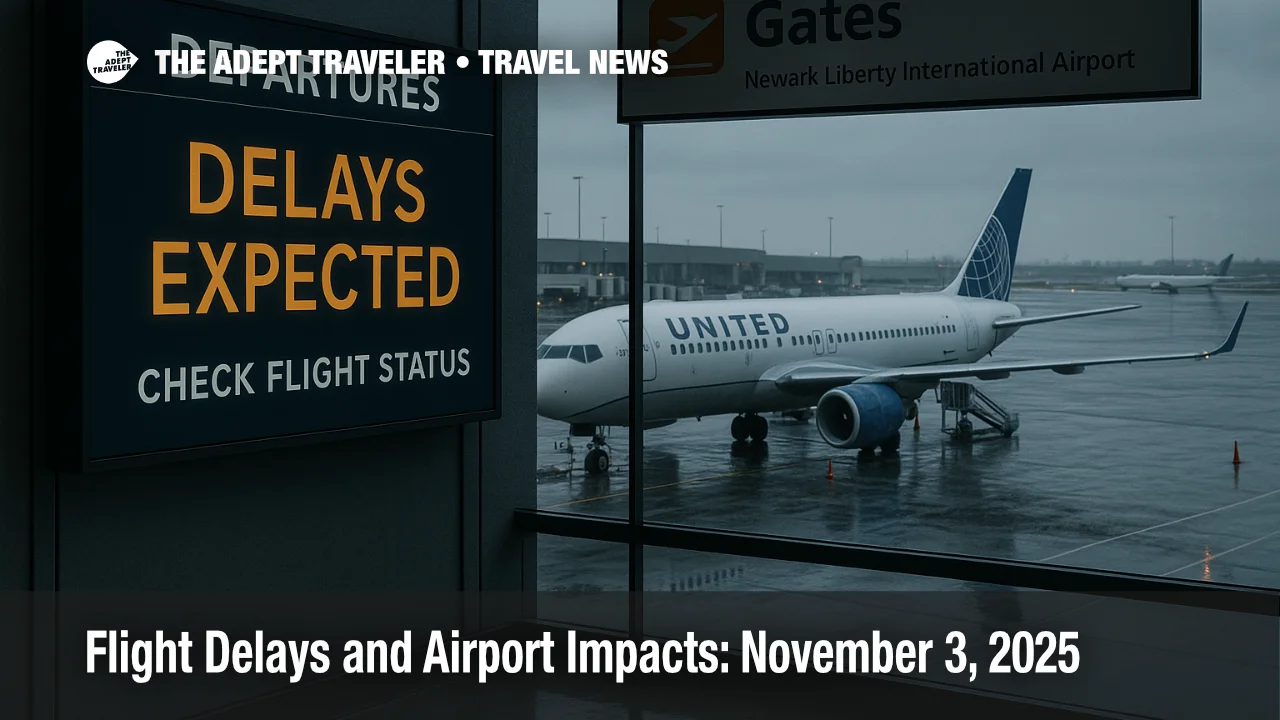Flight Delays and Airport Impacts: November 3, 2025

Key points
- Newark's staffing-driven Ground Delay Program is causing long arrival waits and regional ripple effects
- NYC officials warn delays at Newark can spill to JFK and LaGuardia, so plan longer connections
- Houston's Bush and Hobby airports report multi-hour TSA lines amid federal staffing shortages
- No tropical systems are active, but routine weather and volume programs may still meter traffic
- Check the FAA NAS Status and your airline app for gate holds, revised times, and rebooking options
Impact
- NYC Airports
- Expect extended arrival spacing at Newark with knock-on delays at JFK and LaGuardia
- Houston Airports
- Plan extra time for TSA screening at Bush Intercontinental and Hobby
- Connections
- Build longer buffers or move to earlier flights to protect misconnects
- Rebooking
- Use airline apps and waivers where offered to shift flights outside peak delay windows
- Day-Of Monitoring
- Track FAA NAS Status plus carrier push alerts for ground stops, GDPs, and gate changes
Newark Liberty International Airport (EWR) faces another day of staffing-related air traffic management, with the Federal Aviation Administration planning and revising a Ground Delay Program that is already stretching arrival waits and cascading into the broader New York system. City officials warned on Sunday that Newark arrivals could be limited to low hourly rates, a pattern that tends to spill across to John F. Kennedy International Airport (JFK) and LaGuardia Airport (LGA) during banked connection waves. Travelers should assume longer blocks for arrivals and connections through Monday, November 3, and use carrier apps to rebook if tight connections are at risk.
What changed for travelers today
The FAA's Air Traffic Control System Command Center signaled overnight that Newark's Ground Delay Program would likely be revised for arrivals after 12:00 a.m. ET, indicating continued metering as the day builds. Real-time FAA dashboards will show any additional ground stops, gate holds, or flow programs added for weather or volume elsewhere in the system. When Newark is metered, average delays can exceed an hour, with higher peaks during the morning and late-afternoon banks, and those constraints often propagate to feeder and downline stations.
Houston is a separate pinch point
In Houston, TSA screening remains a pain point. George Bush Intercontinental and William P. Hobby have warned travelers to allow extra time after hours-long queues developed over the weekend and continued into early Monday. If you are departing IAH or HOU today, arrive earlier than normal and prioritize PreCheck or Clear if eligible.
How it works: GDPs, ground stops, and why ripples happen
A Ground Delay Program (GDP) is a traffic-management tool that meters arrivals into a constrained airport by assigning controlled times for takeoff from origins. Constraints can be weather, runway or airspace configuration, equipment outages, or staffing in key facilities. Because Newark shares terminal airspace and flow with JFK and LaGuardia, reduced arrival rates at one field often force holding, rerouting, or gate juggling at the others. Travelers experience this as gate holds, longer taxi-out queues, airborne holding, or missed connections. The FAA's daily planning note and the National Airspace System (NAS) Status site are the most reliable same-day references for these programs.
Latest developments to watch
- Newark program adjustments: Expect revisions as demand builds. If the hourly rate tightens, anticipate added airborne holding and more aggressive reflows from origin cities.
- NYC regional spill: NYC emergency planners flagged the possibility of broader ripple effects, so even JFK and LaGuardia flyers should watch for creeping departure holds and missed connection risk around the hub banks.
- No tropical drivers today: The National Hurricane Center reports no active Atlantic cyclones, so disruption risk is primarily operational and routine weather, not tropical.
- Generalized staffing pressure: Trade and industry reports continue to cite controller and federal staffing constraints amplifying delay magnitudes during peak windows. This background pressure means ordinary weather can trigger outsized effects.
What to do if you are flying today
If you are flying to or through Newark, pad your connection to at least 2 hours on domestic itineraries and longer for international transfers when possible. If your app shows an automatic misconnect, use self-service rebooking tools to move to an earlier feeder or a later long-haul. For New York area flyers with flexibility, consider shifting to off-peak departures or, if practical, booking into or out of the other two airports when inventory is available. In Houston, treat security as a separate constraint: arrive early, redistribute items before screening, and check whether your airline will let you move to a later departure without fees if you are at risk of missing the cutoff. Keep the FAA NAS Status page open alongside your airline app for the most accurate picture of developing ground stops and GDPs.
Final thoughts
Newark's metering and Houston's TSA bottlenecks are today's headliners, but routine fall weather and normal congestion can still add friction elsewhere. Keep plans flexible, watch live FAA and airline updates, and protect your connections by moving earlier where seats exist. That approach minimizes surprises and improves your odds of arriving same-day.
